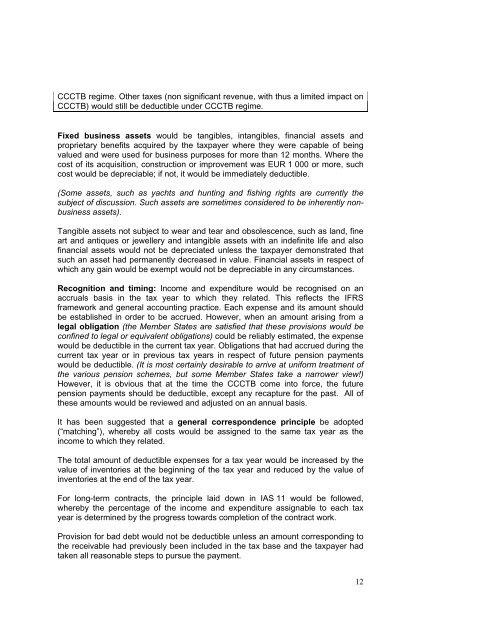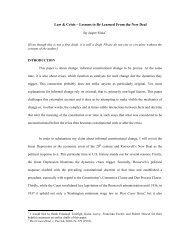An outline of the CCCTB (Common Consolidated Corporate Tax ...
An outline of the CCCTB (Common Consolidated Corporate Tax ...
An outline of the CCCTB (Common Consolidated Corporate Tax ...
You also want an ePaper? Increase the reach of your titles
YUMPU automatically turns print PDFs into web optimized ePapers that Google loves.
<strong>CCCTB</strong> regime. O<strong>the</strong>r taxes (non significant revenue, with thus a limited impact on<br />
<strong>CCCTB</strong>) would still be deductible under <strong>CCCTB</strong> regime.<br />
Fixed business assets would be tangibles, intangibles, financial assets and<br />
proprietary benefits acquired by <strong>the</strong> taxpayer where <strong>the</strong>y were capable <strong>of</strong> being<br />
valued and were used for business purposes for more than 12 months. Where <strong>the</strong><br />
cost <strong>of</strong> its acquisition, construction or improvement was EUR 1 000 or more, such<br />
cost would be depreciable; if not, it would be immediately deductible.<br />
(Some assets, such as yachts and hunting and fishing rights are currently <strong>the</strong><br />
subject <strong>of</strong> discussion. Such assets are sometimes considered to be inherently nonbusiness<br />
assets).<br />
Tangible assets not subject to wear and tear and obsolescence, such as land, fine<br />
art and antiques or jewellery and intangible assets with an indefinite life and also<br />
financial assets would not be depreciated unless <strong>the</strong> taxpayer demonstrated that<br />
such an asset had permanently decreased in value. Financial assets in respect <strong>of</strong><br />
which any gain would be exempt would not be depreciable in any circumstances.<br />
Recognition and timing: Income and expenditure would be recognised on an<br />
accruals basis in <strong>the</strong> tax year to which <strong>the</strong>y related. This reflects <strong>the</strong> IFRS<br />
framework and general accounting practice. Each expense and its amount should<br />
be established in order to be accrued. However, when an amount arising from a<br />
legal obligation (<strong>the</strong> Member States are satisfied that <strong>the</strong>se provisions would be<br />
confined to legal or equivalent obligations) could be reliably estimated, <strong>the</strong> expense<br />
would be deductible in <strong>the</strong> current tax year. Obligations that had accrued during <strong>the</strong><br />
current tax year or in previous tax years in respect <strong>of</strong> future pension payments<br />
would be deductible. (It is most certainly desirable to arrive at uniform treatment <strong>of</strong><br />
<strong>the</strong> various pension schemes, but some Member States take a narrower view!)<br />
However, it is obvious that at <strong>the</strong> time <strong>the</strong> <strong>CCCTB</strong> come into force, <strong>the</strong> future<br />
pension payments should be deductible, except any recapture for <strong>the</strong> past. All <strong>of</strong><br />
<strong>the</strong>se amounts would be reviewed and adjusted on an annual basis.<br />
It has been suggested that a general correspondence principle be adopted<br />
(“matching”), whereby all costs would be assigned to <strong>the</strong> same tax year as <strong>the</strong><br />
income to which <strong>the</strong>y related.<br />
The total amount <strong>of</strong> deductible expenses for a tax year would be increased by <strong>the</strong><br />
value <strong>of</strong> inventories at <strong>the</strong> beginning <strong>of</strong> <strong>the</strong> tax year and reduced by <strong>the</strong> value <strong>of</strong><br />
inventories at <strong>the</strong> end <strong>of</strong> <strong>the</strong> tax year.<br />
For long-term contracts, <strong>the</strong> principle laid down in IAS 11 would be followed,<br />
whereby <strong>the</strong> percentage <strong>of</strong> <strong>the</strong> income and expenditure assignable to each tax<br />
year is determined by <strong>the</strong> progress towards completion <strong>of</strong> <strong>the</strong> contract work.<br />
Provision for bad debt would not be deductible unless an amount corresponding to<br />
<strong>the</strong> receivable had previously been included in <strong>the</strong> tax base and <strong>the</strong> taxpayer had<br />
taken all reasonable steps to pursue <strong>the</strong> payment.<br />
12
















